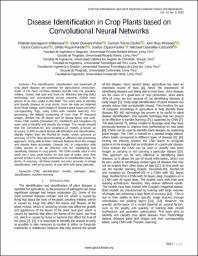Mostrar el registro sencillo del ítem
Disease Identification in Crop Plants based on Convolutional Neural Networks
| dc.contributor.author | Iparraguirre-Villanueva, Orlando | |
| dc.contributor.author | Guevara-Ponce, Victor | |
| dc.contributor.author | Torres-Ceclén, Carmen | |
| dc.contributor.author | Ruiz-Alvarado, John | |
| dc.contributor.author | Castro-Leon, Gloria | |
| dc.contributor.author | Roque-Paredes, Ofelia | |
| dc.contributor.author | Zapata-Paulini, Joselyn | |
| dc.contributor.author | Cabanillas-Carbonell, Michael | |
| dc.date.accessioned | 2023-08-03T19:16:31Z | |
| dc.date.available | 2023-08-03T19:16:31Z | |
| dc.date.issued | 2023 | |
| dc.identifier.uri | https://hdl.handle.net/20.500.13053/9116 | |
| dc.description.abstract | “The identification, classification and treatment of crop plant diseases are essential for agricultural production. Some of the most common diseases include root rot, powdery mildew, mosaic, leaf spot and fruit rot. Machine learning (ML) technology and convolutional neural networks (CNN) have proven to be very useful in this field. This work aims to identify and classify diseases in crop plants, from the data set obtained from Plant Village, with images of diseased plant leaves and their corresponding Tags, using CNN with transfer learning. For processing, the dataset composing of more than 87 thousand images, divided into 38 classes and 26 disease types, was used. Three CNN models (DenseNet-201, ResNet-50 and Inception-v3) were used to identify and classify the images. The results showed that the DenseNet-201 and Inception-v3 models achieved an accuracy of 98% in plant disease identification and classification, slightly higher than the ResNet-50 model, which achieved an accuracy of 97%, thus demonstrating an effective and promising approach, being able to learn relevant features from the images and classify them accurately. Overall, ML in conjunction with CNNs proved to be an effective tool for identifying and classifying diseases in crop plants. The CNN models used in this work are a very good choice for this type of tasks, since they proved to have a very high performance in classification tasks. In terms of accuracy, all three models are very accurate in image classification, with an accuracy of over 96% with large data sets“ | es_PE |
| dc.format | application/pdf | es_PE |
| dc.language.iso | eng | es_PE |
| dc.publisher | Science and Information Organization | es_PE |
| dc.rights | info:eu-repo/semantics/openAccess | es_PE |
| dc.rights.uri | https://creativecommons.org/licenses/by/4.0/ | es_PE |
| dc.subject | "CNN; identification; models; pathogen; plant; classification; machine learning" | es_PE |
| dc.title | Disease Identification in Crop Plants based on Convolutional Neural Networks | es_PE |
| dc.type | info:eu-repo/semantics/article | es_PE |
| dc.type.version | info:eu-repo/semantics/publishedVersion | es_PE |
| dc.publisher.country | AT | es_PE |
| dc.subject.ocde | 1.02.00 -- Informática y Ciencias de la Información | es_PE |
Ficheros en el ítem
Este ítem aparece en la(s) siguiente(s) colección(es)
-
SCOPUS [380]


